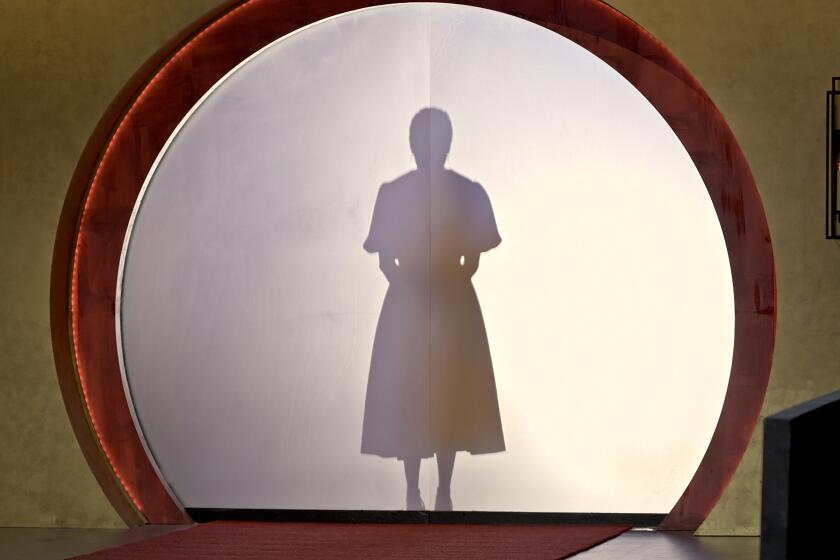LACMA draws up ambitious plans for a $650-million new look
At the Los Angeles County Museum of Art, an acclaimed Swiss architect is hoping to pull off what an acclaimed Dutch one could not.
Next month LACMA will publicly unveil a $650-million plan by Pritzker Prize winner Peter Zumthor for a dramatic new museum building along Wilshire Boulevard.
If completed it would rank as one of the most significant works of architecture to rise in Los Angeles since Frank Gehry’s Walt Disney Concert Hall opened 10 years ago. It would also require demolishing the core of the museum’s campus, including the original 1965 buildings by William L. Pereira and a 1986 addition by Hardy Holzman Pfeiffer Associates of New York.
GRAPHIC: On the chopping block at LACMA
In scope and ambition, the Zumthor plan is reminiscent of a proposal by Dutch architect Rem Koolhaas that would have razed the main museum campus and replaced it with a collection of low-slung gallery buildings under a giant, tent-like translucent roof. The LACMA board approved that project in 2001, but after fundraising struggles museum officials dropped the effort less than two years later.
Museum Director Michael Govan is convinced he can help the latest design avoid a similar fate. He has worked since his arrival at LACMA in 2006 to groom a new generation of donors and enlarge the museum’s board, which he believes is now ready to launch a $650-million capital campaign to finance the new building. The construction cost is estimated to be at least $450 million, with the remaining $200 million earmarked for expenses including contingencies and operations.
Govan has overseen the completion of several major additions to the museum after the collapse of the Koolhaas plan — including two buildings on the west side of the LACMA campus by architect Renzo Piano, the Broad Contemporary Art Museum and the Resnick Pavilion. Those buildings and their 100,000 square feet of gallery space will allow the museum to stay open during construction of the Zumthor building.
Zumthor’s proposal would leave those new buildings and Bruce Goff’s 1988 Pavilion for Japanese Art untouched. It would not affect the former May Co. building, an Art Deco landmark where the Academy of Motion Picture Arts and Sciences is planning a $300-million film museum.
Instead it calls for a horizontal building along Wilshire Boulevard, east of “Urban Light,” Chris Burden’s installation of vintage street lamps. It would be wrapped in glass on all sides, and its main galleries would be lifted one floor into the air. The wide roof would be covered with solar panels.
PHOTOS: Arts and culture by The Times
From above, the structure would resemble an inkblot or a drop of water. Zumthor says the design has been inspired more by the oozing, fluid forms of the La Brea Tar Pits just east of the museum than the existing architecture at LACMA.
The new plan presents obvious pitfalls. Though very costly, it will essentially replace the square footage of the Pereira and Hardy Holzman Pfeiffer buildings rather than giving the museum any additional gallery space.
It will require Zumthor, who turned 70 last week, to adapt his highly precise and deliberate style to a crowded site in the heart of Los Angeles. The architect, who in 2009 was awarded the Pritzker, his profession’s highest honor, has rarely worked outside central Europe, though he did spend time in 1988 teaching at the Southern California Institute of Architecture. With the exception of the Kolumba Museum in Cologne, Germany, which opened in 2007, nearly all of his important buildings are located near his office in the small Swiss mountain town of Haldenstein, population 1,000.
By developing a design first and raising money second, Govan is turning typical museum-building protocol on its head. He will be asking trustees and other donors to help pay for an architectural vision that they have played little or no role in crafting.
The fundraising push for the Zumthor building will also come on the heels of Govan’s attempt, so far unsuccessful, to have LACMA acquire the embattled Museum of Contemporary Art downtown. That effort has drained time and energy from other LACMA projects, including work on the Zumthor proposal.
PHOTOS: LACMA Art + Film Gala 2012
In the new project Govan and Zumthor will also have to face down the ghosts of failed plans at LACMA’s campus. Indeed, one constant of the museum’s history is that its Wilshire Boulevard site seems in equal measure to invite and frustrate grand architectural thinking.
In the early 1960s, as planning for the move to Wilshire from the museum’s old site in Exposition Park gained speed, Director Richard Fargo Brown hoped to hire the German Modernist Ludwig Mies van der Rohe — then among the most prominent architects in the world. Howard Ahmanson, the major donor, favored the American Edward Durell Stone. Pereira, based in Los Angeles, emerged as a compromise solution.
The Pereira buildings — officially the Ahmanson, Hammer and Bing wings — have never been beloved by curators, artists or the public. When they opened, the influential Arts & Architecture magazine suspended its policy of publishing only those projects that it felt were “of exceptional architectural merit” to run an extensive spread criticizing the new museum as “pitiful” and marked by “faults we believe to be inexcusable in an architect of Mr. Pereira’s experience and stature.”
Rather than clarifying circulation through the museum, the 1986 addition — now called the Art of the Americas building — seemed to further complicate it. It also had the effect of sealing the museum off from Wilshire Boulevard.
The Los Angeles County Board of Supervisors, which would have to approve any new construction, did not oppose the idea of demolition when the Koolhaas plan was made public. Neither did the Los Angeles Conservancy, a historic-preservation advocacy group.
PHOTOS: Pacific Standard Time artists from the Times’ archives
Govan argues that the Zumthor building will be far more efficient than the ones it would replace, potentially saving LACMA as much as $5 million per year in operating costs. Like the Koolhaas proposal, the Zumthor design is an effort to redefine the encyclopedic museum for the 21st century, trading stately and respectable architecture for something more adventurous.
Yet the members of the families whose names are attached to the older buildings may not be universally pleased with the notion of demolishing them. That may slow the Zumthor proposal as it did the Koolhaas one.
The new design, still in a preliminary phase, will be shown to the public for the first time in June in an exhibition at LACMA called “The Presence of the Past: Peter Zumthor Reconsiders LACMA.” The show is part of the Getty-sponsored series Pacific Standard Time Presents: Modern Architecture in L.A. Along with sketches and models of the proposed building and a small retrospective of Zumthor’s built work, the exhibition will include excerpts from a filmed conversation between Govan and Zumthor discussing the project.
The larger Pacific Standard Time series may serve to complicate the debate over the Zumthor plan. Even as it makes room for forward-looking exhibitions like LACMA’s, the main thrust of the Getty project is to bring new attention to L.A.’s late-modern architecture, particularly work from the 1950s and ‘60s.
Pereira’s architecture is featured prominently in “Overdrive,” the anchor exhibition of the PSTP series. Whether that new spotlight will mean fresh public or political support for his much-maligned buildings at LACMA, of course, remains to be seen.
christopher.hawthorne@latimes.com
More to Read
The biggest entertainment stories
Get our big stories about Hollywood, film, television, music, arts, culture and more right in your inbox as soon as they publish.
You may occasionally receive promotional content from the Los Angeles Times.











